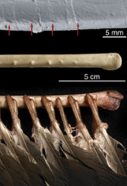Feathered fossils
Scientists have discovered evidence of feathers on one of the biggest dinosaurs yet.
By Emily Sohn
As dinosaurs go, Velociraptor mongoliensis is fairly famous. Three starred in the 1993 film Jurassic Park.
Despite the creature’s fame, scientists have found remains from only about 20 velociraptors. Most of those discoveries turned up in the last 15 years or so, says Alan H. Turner, a paleontologist at the American Museum of Natural History in New York City.
After a close look at some ancient bones, Turner and colleagues recently made a surprising discovery about velociraptors. They found the first direct evidence of big feathers on a relatively large dino.
 |
|
This velociraptor dinosaur’s forearm bone (top) has regularly spaced bumps, similar to those on the forearm bone of a modern turkey vulture (middle and bottom). These bumps show where large feathers were probably attached.
|
| Science |
The researchers looked at velociraptor fossils found in Asia’s Gobi Desert in 1998. The bones belonged to a dino that was 1.5 meters (5 feet) long. The creature lived 80 million years ago. And scientists have found 60 percent of its bones.
During their analysis, the researchers were surprised to discover six bumps on one of the animal’s forearm bones. The bumps were spaced regularly about 4 millimeters (0.2 inch) apart. Each bump measured about 0.8 mm (0.03 inch) across.
These features had never before been observed on a velociraptor, but they are common on the arm bones of some modern birds. Called quill knobs, the bumps reveal where bone-connecting tissue (called ligaments) attaches major flight feathers to the bone.
Not all birds have these knobs. And members of the same bird species often have different numbers of bumps. Still, the presence of quill knobs means that feathers were definitely once connected there.
In further support of the feathered conclusion, the bumps on the velociraptor fossil were rough in texture. The quill knobs of modern birds are similarly rough where ligaments attach.
Turner’s team found six bumps on their velociraptor’s arm. Based on the spacing of knobs, however, the scientists believe that the animal could have had as many as 14 large feathers on each forelimb. Some of the feathers may have not been attached to quill knobs.
Researchers had previously found feathers on several small dinosaurs that are closely related to velociraptors. Members of those species, which belonged to the genus Microraptor, were usually less than 1 meter (3.2 feet) long. These creatures most likely used their feathers to glide from tree to tree.
Velociraptors, however, couldn’t have used their feathers to fly or glide through the air because the animals were too big and heavy. The creature that Turner’s team studied, for example, probably weighed about 15 kilograms (33 pounds). It would have measured 1 meter (3.2 feet) from its hip to its toes.
Nor would the feathers have helped the dinosaurs stay warm. That’s because there were too few of the feathers to significantly influence body temperature.
Instead, velociraptors may have used their feathers to shield their nests from sunlight or from the eyes of hungry predators. It is also possible that the feathers helped the dinos change directions more quickly or leap higher, Turner suggests.
“This goes to show that even a well-known dinosaur like Velociraptor [mongoliensis] can still provide surprises,” says Thomas R. Holtz Jr., a vertebrate paleontologist at the University of Maryland at College Park.—Emily Sohn
Going Deeper:
Perkins, Sid. 2007. Bumpy bones: Fossil hints that dinosaur had feathery forearms. Science News 172(Sept. 22):181-182. Available at http://www.sciencenews.org/articles/20070922/fob6.asp .
Rehmeyer, Julie J. 2006. Flying on wings and legs. Science News for Kids (Sept. 27). Available at http://www.sciencenewsforkids.org/articles/20060927/Note3.asp .
Sohn, Emily. 2007. An ancient feathered biplane. Science News for Kids (Jan. 31). Available at http://www.sciencenewsforkids.org/articles/20070131/Note3.asp .







